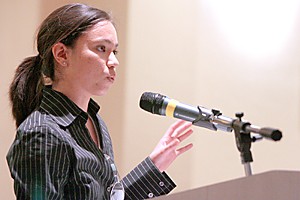Two student leaders last night debated the merits of whether a $40 union fee would benefit all students, but many of the facts they cited were incorrect or misunderstood, according to previous interviews with the union director.
The Arizona Student Unions is proposing a mandatory fee for all UA students that would be used to rebuild the union’s dwindling reserve fund, repair and renovate buildings and add more programs for students.
If students approve the fee in a special election April 11 and 12, an extra $20 will be added to tuition in 2007. An additional $10 will be added each year until 2009, when the fee would reach $40.
When the fee reaches the maximum $40, the unions could generate an extra $1.4 million per year, from which $700,000 would be spent on program enhancements including club funding, a discounted concert program and leadership development, according to the proposed union budget.
Throughout the debate last night, the two debaters expressed misconceptions about why union officials first drafted the proposed fee and what would happen if the fee wasn’t approved.
Bridgette Gallagher, president of the University Activities Board, argued that the fee dollars would make it possible for groups in the Center for Student Involvement and Leadership, which supports the 541 recognized UA clubs, to receive scholarship money or funds to put toward tuition, Gallagher said.
But that’s not what the fee was originally intended to do, according to a previous e-mail from Dan Adams, director of the Arizona Student Unions.
Adams wrote in an e-mail Feb. 23 that the need for the fee stemmed from increases in employee expenses and benefits, costing the unions an extra $850,000 it wasn’t prepared for and not out of a desire to increase funding for CSIL.
Hikes in product prices and services have also created expenses, along with upcoming building renewal projects such as the $400,000 needed to replace the Park Student Union roof, Adams wrote.
These increases require more funds, but the fee would allocate 25 percent of revenue toward building renewal. Fifty percent of the money received would go toward funding programs, and the remaining 25 percent would go to service enhancements such as remodeling and extending service hours of campus eateries.
Adams was invited to last night’s open forum and debate but was unable to make it because he was out of town, said ASUA Sen. Rhonda Tubbs, mediator of the forum.
If the fee isn’t approved, Gallagher said a mandatory meal plan could be another option, and Burns said he thinks administration is using a meal plan as leverage to gain support for a fee.
But Adams said the meal plan idea has been dropped because there is not enough student support. Without student support, it’s unlikely the Arizona Board of Regents would pass a mandatory meal plan, said voting student Regent Ben Graff in a previous interview.
If the fee is not approved, Adams said prices of products and services in the unions will increase and programs will be cut instead.
Without a fee, next year’s budget includes an across-the-board 5 percent increase on all sales and service items. The building hours of late-night facilities, like Cellar and the Games Room, will also be reduced.
Programs like the Center for Student Involvement and Leadership are also scheduled to be cut if the fee isn’t approved, Adams said.
Besides discussing why the fee was necessary, the two leaders also argued over how the money should be allocated.
“”A majority of this money is being focused on benefiting the students who live on campus, and the unions want to tax everybody for it,”” said Brad Burns, university relations director of the Associated Students of the University of Arizona.
Burns, who said his opinion does not reflect ASUA, argued that while programs are important for student development, he is concerned fee dollars would be misspent and directed more toward undergraduate students involved in campus clubs and organizations.
Though graduate student and family programs each would receive $10,000 in 2007, funding for residence hall programming is marked at $12,500 with club funding marked at $37,500, according to the budget.
“”That’s not equal funding,”” said Burns, a political science sophomore.
Becca Rodl, a political science sophomore and ASUA assistant elections commissioner, asked how students who aren’t involved in campus activities would equally benefit from an across-the-board fee.
But Gallagher said the dollars going to clubs and groups like Greek Life and Blue Chip could benefit all students, even those not involved in extracurricular activities.
“”We do recognize that not everyone is in a club or organization, but the money that goes to those groups can open up opportunities for all students on campus,”” said Gallagher, a political science senior. “”Greek Life can put on more campuswide philanthropies, we can offer more and better concerts at cheaper ticket prices.””
If the fee passes and students think the money is not being spent wisely, they can voice their concerns to the Student Union Fee Committee, which comprises 11 students, three of whom are chosen by an application process, said Gallagher, who would sit on the committee.
“”But what about the students who can’t afford paying the fee?”” asked Samantha Kerr, a pre-health education sophomore.
Gallagher said an opt-out process would be available for those who couldn’t afford a new fee, but according to an e-mail from Adams on March 1, the opt-out process is intended only for those who can prove they don’t use the union’s services – not for those who can’t afford it.









